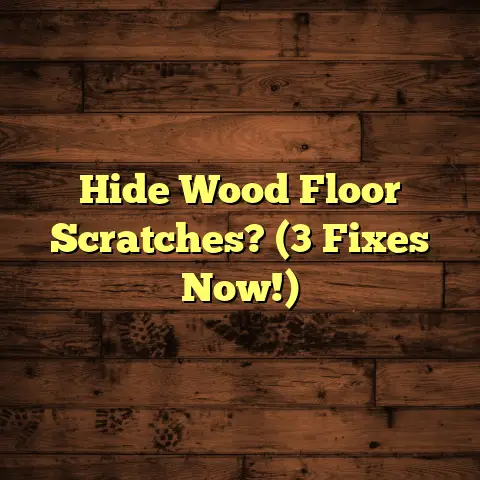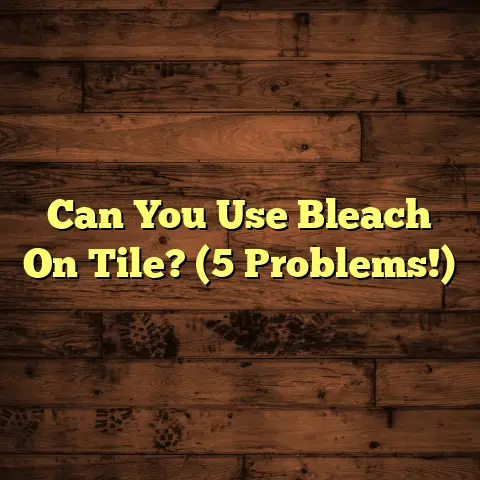Epoxy Floor Durability? (2 Year Lifespan?)
They’re super popular, right?
I see them everywhere, from garages to fancy stores.
They look great and promise to protect your floor.
But how long do they really last?
That’s the big question.
Specifically, what can you expect after two years?
Let’s dive in and find out!
Section 1: Understanding Epoxy Flooring
So, what is epoxy flooring anyway?
Well, it’s basically a thermosetting resin system.
Sounds complicated, I know!
Think of it like this: you mix epoxy resin with hardeners.
This creates a chemical reaction.
The result?
A super strong, durable, and seamless surface.
It’s like giving your floor a tough shield.
Types of Epoxy Flooring
There are a few different types you should know about:
-
Solid Epoxy: This is the heavy-duty stuff. It’s almost 100% epoxy solids and incredibly tough.
-
Water-Based Epoxy: This is more eco-friendly. It has lower VOCs (volatile organic compounds).
-
Solvent-Based Epoxy: This type is known for its excellent adhesion and durability. But it does have stronger fumes.
Each type has its own pros and cons.
The best choice depends on your specific needs.
Where Do We Use Epoxy Floors?
Epoxy floors are incredibly versatile!
I’ve installed them in all sorts of places:
-
Garages: Perfect for withstanding oil spills and heavy traffic.
-
Basements: Great for waterproofing and making the space more usable.
-
Commercial Kitchens: Easy to clean and resistant to bacteria.
-
Warehouses: Can handle forklifts and heavy machinery.
Basically, anywhere you need a tough, durable, and good-looking floor, epoxy can be a great option.
Section 2: Factors Influencing Epoxy Floor Durability
Okay, let’s talk about what really makes an epoxy floor last.
It’s not just about the epoxy itself.
Many things play a role.
Quality of Materials
This is HUGE.
You get what you pay for.
Cheap epoxy might save you money upfront.
But it will likely crack, peel, and fail much sooner.
I always recommend using high-quality epoxy resins.
Look for ones with good UV resistance if it’s an area with sunlight.
Thickness matters too!
Thicker coatings generally last longer.
Installation Process
This is where a professional really shines.
Proper prep is key.
The concrete needs to be clean, dry, and properly etched.
If you skip steps, the epoxy won’t bond correctly.
DIY can be tempting, but trust me, it’s easy to mess up.
Priming is also crucial.
It helps the epoxy adhere and creates a smooth surface.
Curing times are important too.
You need to let the epoxy fully harden before using the floor.
Rushing this can lead to problems down the road.
Environmental Conditions
Think about where you’re installing the epoxy.
Temperature and humidity can affect the curing process.
Extreme temperatures can also cause the epoxy to expand and contract, leading to cracks.
Chemical exposure is another big one.
Some chemicals can damage epoxy coatings.
If you’re in a garage or workshop, make sure the epoxy is resistant to oils, solvents, and other chemicals.
Heavy traffic is tough on any floor.
In high-traffic areas, you might need a thicker, more durable epoxy coating.
Maintenance Practices
Regular cleaning is essential.
Sweep or vacuum regularly to remove dirt and debris.
This prevents scratches and keeps the floor looking its best.
Use mild soap and water for cleaning.
Avoid harsh chemicals that can damage the epoxy.
I also recommend using mats in high-traffic areas.
This helps protect the floor from wear and tear.
Section 3: The 2-Year Lifespan of Epoxy Floors
Alright, let’s get to the heart of the matter: the 2-year lifespan.
Is that all you can expect from an epoxy floor?
Well, it depends.
A properly installed, high-quality epoxy floor should last much longer than two years.
I’ve seen them last 5, 10, even 20 years with proper care.
But, a poorly installed or low-quality epoxy floor?
Two years might be optimistic.
What Happens in 2 Years?
After two years, you might start to see some wear and tear:
-
Surface Scratches and Abrasions: From foot traffic, equipment, or dropped objects.
-
Stains and Spills: Especially if you don’t clean them up quickly.
-
UV Exposure: Fading or discoloration in areas with direct sunlight.
-
Loss of Gloss: The floor might not be as shiny as it was when it was new.
These are all normal signs of wear.
But if you see significant peeling, cracking, or other damage, that’s a red flag.
According to a study by the “Epoxy Floor Coating Association,” high-quality epoxy floors in residential settings can maintain their integrity for up to 5 years with minimal signs of wear, provided regular maintenance is performed.
Section 4: Real-Life Case Studies
Let me share a couple of stories from my own experience.
Case Study 1: The Garage Makeover
I worked with a homeowner who wanted to transform his garage.
He chose a metallic epoxy finish.
It looked amazing!
Two years later, I checked in with him.
He said the floor still looked great.
He had a few minor scratches from dropping tools.
But overall, he was thrilled with the durability.
He made sure to clean up spills right away.
And he used mats under his workbench.
Case Study 2: The Commercial Kitchen
I installed epoxy flooring in a commercial kitchen.
This was a much tougher environment.
Lots of foot traffic, hot oil spills, and harsh cleaning chemicals.
After two years, the floor was showing some wear.
There were a few stains and some minor damage around the drains.
But overall, the epoxy was holding up well.
The key was regular cleaning and maintenance.
They also had a professional cleaning service come in every few months to deep clean the floor.
These case studies show that epoxy floors can last.
But it depends on the environment and how well you take care of them.
Section 5: Signs of Wear and When to Replace
How do you know if your epoxy floor is nearing the end?
Here are some signs to look for:
-
Peeling or Flaking: This is a sign that the epoxy is losing its adhesion.
-
Discoloration or Fading: Especially in areas with sunlight exposure.
-
Visible Cracks: Small cracks can be repaired. But large, widespread cracks indicate a bigger problem.
-
Damage from Impact: Chips or dents from dropped objects.
If you see any of these signs, it’s time to take action.
Small cracks and chips can often be repaired.
But if the damage is extensive, you might need to replace the floor.
I always recommend getting a professional opinion.
A contractor can assess the damage and recommend the best course of action.
Section 6: Repairing and Refreshing Epoxy Floors
Good news!
You don’t always have to replace the entire floor.
Sometimes, you can repair or refresh the epoxy to extend its life.
Repairing Minor Damage
For small cracks and chips, you can use an epoxy repair kit.
These kits typically include epoxy resin, hardener, and filler.
Follow the instructions carefully.
Clean the damaged area, mix the epoxy, and apply it to the crack or chip.
Let it cure completely before using the floor.
Refreshing the Floor
If the floor is just looking dull or scratched, you can apply a new top coat.
This will restore the shine and protect the underlying epoxy.
First, clean the floor thoroughly.
Then, lightly sand the surface to create a good bond.
Apply a thin, even coat of epoxy topcoat.
Let it cure completely before using the floor.
Another option is to completely resurface the floor.
This involves grinding down the existing epoxy and applying a new coating.
This is a more involved process.
I recommend hiring a professional for this.
Section 7: Conclusion
So, what’s the verdict on epoxy floor durability?
A 2-year lifespan is definitely on the low end.
But it’s possible if you don’t choose the right materials or install it properly.
The key takeaways are:
-
Quality Matters: Invest in high-quality epoxy resins and hardeners.
-
Professional Installation: Don’t cut corners on installation. Hire a qualified contractor.
-
Regular Maintenance: Clean your floor regularly and address any damage promptly.
With the right care, your epoxy floor can last for many years.
It’s an investment that can add value and beauty to your home or business.
I hope this article has been helpful!
If you have any questions, feel free to reach out.
I’m always happy to share my expertise.





